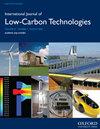Analysis of thermoelectric effect of wet spun graphene fiber composites
IF 2.3
4区 工程技术
Q3 ENERGY & FUELS
引用次数: 0
Abstract
In this manuscript, we have theoretically reanalyzed data prepared and already published by Foroughi et al.[1]. These data concern the thermal energy dependence of the electrical conductivity of the samples: Graphene fiber, graphene/Poly(3,4-ethylenedioxythiophene)(graphene/PEDOT), graphene/ carbone nanotube(graphene/CNT) and graphene/carbone nonotube/Poly(3,4-ethylenedioxythiophene)(graphene/CNT/PEDOT) composite fibers. We investigate the behavior of the thermal conductivity for these four samples. These samples are considered as thermoelectric materials or green energy conversion materials using the Seebeck effect to transform heat into electrical energy and vice versa. In this context, the optimization of the ZT merit factor remains a challenge for the scientific community. The objective of this investigation is to evaluate and characterize the thermoelectric efficiency of the above-mentioned samples. We confront the experimental data with the existing theoretical models. The thermoelectric efficiency is generally characterized by the merit factor ZT. The maximum ZT of about 1,2 is obtained in the graphene fiber and between 0,1 et 0,2 in the others samples. The performance of the material depends on ZT, indeed a high ZT ($ZT\ge 1$ ) corresponds to a better optimization of the composite.湿纺石墨烯纤维复合材料的热电效应分析
在这篇论文中,我们从理论上重新分析了Foroughi等人准备和已经发表的数据。这些数据涉及样品电导率的热能依赖性:石墨烯纤维、石墨烯/聚(3,4-乙烯二氧噻吩)(石墨烯/PEDOT)、石墨烯/碳纳米管(石墨烯/CNT)和石墨烯/碳纳米管/聚(3,4-乙烯二氧噻吩)(石墨烯/CNT/PEDOT)复合纤维。我们研究了这四种样品的导热性能。这些样品被认为是热电材料或利用塞贝克效应将热能转化为电能的绿色能源转换材料。在此背景下,优化ZT的性能因子仍然是科学界面临的一个挑战。本研究的目的是评价和表征上述样品的热电效率。我们将实验数据与现有的理论模型进行了比较。热电效率一般用性能因子ZT来表征。在石墨烯纤维中获得的ZT最大值约为1,2,在其他样品中获得的ZT最大值在0,1至0,2之间。材料的性能取决于ZT,事实上,高ZT ($ZT\ge 1$)对应于复合材料的更好的优化。
本文章由计算机程序翻译,如有差异,请以英文原文为准。
求助全文
约1分钟内获得全文
求助全文
来源期刊

International Journal of Low-carbon Technologies
Engineering-Architecture
CiteScore
4.30
自引率
4.30%
发文量
106
审稿时长
27 weeks
期刊介绍:
The International Journal of Low-Carbon Technologies is a quarterly publication concerned with the challenge of climate change and its effects on the built environment and sustainability. The Journal publishes original, quality research papers on issues of climate change, sustainable development and the built environment related to architecture, building services engineering, civil engineering, building engineering, urban design and other disciplines. It features in-depth articles, technical notes, review papers, book reviews and special issues devoted to international conferences. The journal encourages submissions related to interdisciplinary research in the built environment. The journal is available in paper and electronic formats. All articles are peer-reviewed by leading experts in the field.
 求助内容:
求助内容: 应助结果提醒方式:
应助结果提醒方式:


